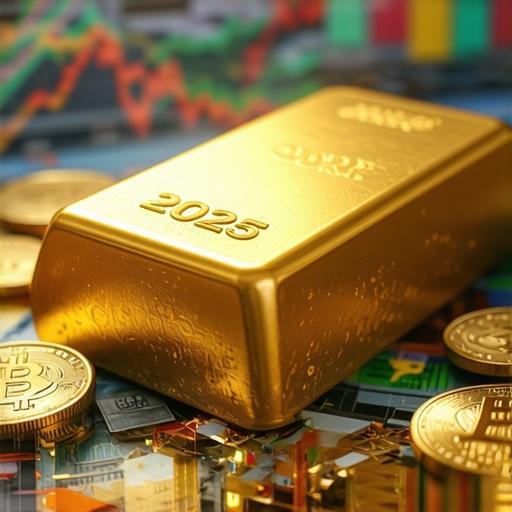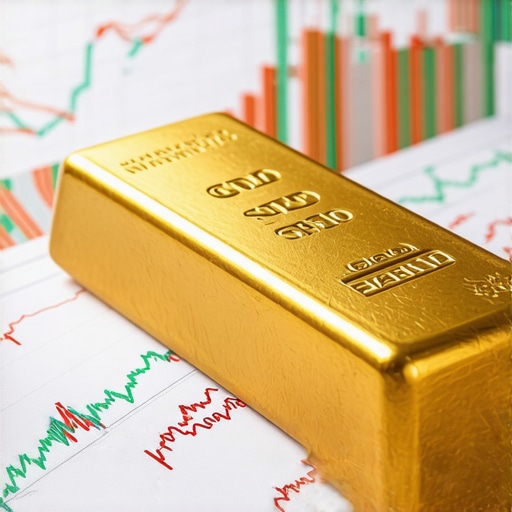How I Noticed the Sparkle Behind Gold Prices
I still remember the day I walked into a local jewelry store and was mesmerized not just by the glittering gold pieces but by the stories they carried. It was my first real encounter with how deeply jewelry influences gold demand trends. From that moment, I started digging deeper into why jewelry remains such a powerful driver of gold prices globally.
Why Jewelry Holds the Key to Gold’s Market Movements
In my experience, jewelry accounts for a significant share of global gold consumption—over 50% according to reports from the World Gold Council. What fascinates me is how cultural traditions, fashion trends, and economic shifts intertwine to push demand up or down. For example, during festive seasons in countries like India and China, I’ve seen gold prices often spike as people buy jewelry for weddings and celebrations.
This consumer behavior isn’t just sentimental; it has strong economic implications. Jewelry demand directly impacts how much gold is bought from mines and recycled sources, affecting supply and eventually prices. When demand surges, prices tend to rise, reflecting scarcity and consumer preference combined.
What Makes Jewelry Demand So Resilient Even in Tough Economic Times?
That question intrigued me for a while. Unlike industrial gold demand, which fluctuates with tech cycles, jewelry demand often stays steady or even grows during uncertain financial periods. I believe this is because gold jewelry is seen as both a luxury and a store of value, especially in regions where gold has cultural importance.
For instance, during inflationary periods or currency instability, families might invest in gold jewelry not just for adornment but as a hedge against economic risks. This dual role strengthens jewelry’s influence on gold prices, creating a unique demand dynamic that investors and enthusiasts like me watch closely.
How Understanding These Trends Helped Me Navigate Gold Investing
Learning about the link between jewelry demand and gold prices transformed how I approach gold as an investment. Instead of just tracking market prices, I began following cultural calendars, economic indicators, and even fashion trends to anticipate demand shifts.
If you’re interested in diving deeper, I recommend exploring insightful resources like the World Gold Council’s market data and detailed analyses on gold demand trends. Their reports helped me understand the broader market beyond mere price charts.
Also, if you want practical tips on how to protect your wealth through strategic gold investments, check out this guide on gold demand trends and smart investing approaches. It’s been a valuable resource in my journey.
Join the Conversation: What’s Your Take on Jewelry’s Role in Gold Prices?
I’d love to hear your experiences or thoughts about how jewelry influences gold demand in your part of the world. Have you noticed seasonal price changes tied to cultural events? Or do you see other factors driving gold prices more significantly? Share your perspectives in the comments below or reach out if you want to discuss gold investing strategies.
Exploring Regional Nuances: How Cultural Preferences Affect Jewelry Demand
One of the more nuanced aspects I discovered is how different regions prioritize various forms of gold jewelry, impacting demand patterns uniquely. For example, in the Middle East, intricate gold necklaces and bracelets are highly coveted, while in South Asia, gold coins and bangles are traditional staples for gifting during weddings and festivals. These regional preferences not only influence the volume of gold demanded but also affect the types of gold products that become popular, which in turn plays a subtle role in pricing dynamics globally.
Understanding these localized trends allows investors and traders to anticipate demand surges or slowdowns more accurately. For instance, tracking wedding seasons in India or Ramadan in the Middle East can provide predictive insights into short-term gold demand spikes, thus influencing market timing strategies.
How Does Jewelry Demand Interact with Global Economic Indicators?
Gold jewelry demand does not exist in isolation; it is intricately connected to macroeconomic conditions. Rising disposable incomes in emerging markets often translate into increased spending on gold jewelry, signaling potential upward pressure on gold prices. Conversely, economic downturns can curb luxury spending but might simultaneously boost gold purchases as a safe haven, especially in culturally gold-centric societies.
Moreover, currency fluctuations affect the affordability of gold jewelry in various countries. A weakening local currency can make imported gold jewelry more expensive domestically, potentially dampening demand or redirecting it towards locally sourced gold pieces. These dynamics underscore the importance of integrating economic data with cultural and seasonal factors for a comprehensive understanding of jewelry-driven gold price movements.
Can Investors Leverage Jewelry Demand Cycles to Optimize Gold Investment Timing?
This question is pivotal for those aiming to maximize returns in gold investments. By analyzing historical data and market reports, investors can identify recurring patterns linked to jewelry demand peaks, such as festive seasons or economic recoveries in key markets. For example, the World Gold Council highlights that India’s wedding season consistently drives significant jewelry demand, which often precedes price upticks. Incorporating these demand cycles into investment strategies can provide a timing advantage in both buying and selling gold assets.
However, it’s essential to recognize that jewelry demand is only one of many factors influencing gold prices. Investors should also consider broader market trends, geopolitical events, and supply-side constraints to form a well-rounded investment approach. For a deeper dive into these factors and effective timing strategies, consider reviewing this detailed analysis of gold price drivers that complements jewelry demand insights.
Integrating Jewelry Demand Insights with Portfolio Diversification
From my experience, blending knowledge of jewelry demand trends with other gold investment types can enhance portfolio resilience. For instance, physical gold jewelry investments offer cultural and sentimental value but may have liquidity limitations compared to gold ETFs or mining stocks. Recognizing when jewelry demand is peaking can guide investors on when to convert physical assets or rebalance holdings towards more liquid instruments.
In practice, this means monitoring not only jewelry market indicators but also staying informed about technological advances impacting industrial gold demand and central bank policies affecting reserves. This multi-dimensional analysis helps in building a balanced gold portfolio that capitalizes on the strengths of each investment form.
For practical advice on creating such diversified portfolios, explore our comprehensive guide on top gold investment strategies designed to optimize returns while managing risk effectively.
Why Trust Established Research in Navigating Jewelry-Driven Gold Markets?
Throughout my journey, I’ve found that relying on reputable sources like the World Gold Council is indispensable. Their extensive research and market insights provide authoritative data that cuts through market noise. For example, their reports on global gold demand trends offer granular details that help contextualize jewelry’s impact relative to other sectors.
According to the World Gold Council, jewelry demand accounted for approximately 53% of total gold demand in 2023, underscoring its dominant role. This kind of credible data empowers investors to make informed decisions rather than speculative guesses.
Access to such expert analysis is crucial, especially in volatile markets where misinformation can lead to costly mistakes. Therefore, I always recommend complementing personal observations with trusted market intelligence for a robust investment strategy.
Join the Discussion: How Do You Factor Jewelry Demand in Your Gold Investment Plans?
Have you noticed specific cultural or seasonal trends impacting gold prices in your region? How do you balance jewelry demand considerations against other market factors when investing in gold? Your insights could provide valuable perspectives for fellow investors navigating this complex market.
Please share your experiences or questions in the comments below, or join the conversation on social media. Engaging with a community of informed investors enriches our collective understanding and sharpens our investment acumen.
Reflecting on the Emotional and Financial Layers of Gold Jewelry Demand
Over the years, I’ve come to appreciate that gold jewelry isn’t just a commodity; it’s a vessel for emotions, heritage, and financial security. This blend creates a compelling narrative around gold demand that goes far beyond simple market metrics. When a family passes down a gold necklace through generations, it’s not just the metal’s weight that matters — it’s the stories, the cultural identity, and the trust embedded in that piece. This emotional attachment often translates into a more resilient demand, even when global economic conditions are uncertain.
Such nuances got me thinking: How can investors factor in these intangible yet powerful drivers when navigating gold markets? It’s a question that often leads me back to trusted research, like the World Gold Council’s detailed demand reports, which contextualize jewelry’s unique role alongside other gold sectors (Understanding Global Gold Demand).
When Culture Meets Capital: Navigating Jewelry Demand’s Complex Market Impact
In my journey, I noticed a fascinating tension: while economic indicators can predict broad gold price trends, localized cultural phenomena often create short-term yet impactful price fluctuations. For instance, in the Middle East, the gold market reacts not only to global supply but significantly to occasions like Eid or weddings, which can cause sudden spikes in jewelry demand and thus gold prices. These culturally driven surges can sometimes seem disconnected from global economic data, making them tricky but rewarding to anticipate.
Recognizing this, I started integrating cultural calendars and regional consumer behavior into my gold investment strategies, enhancing timing precision. If you want to explore how to weave these insights into your approach, the guide on gold demand trends and savvy investing offers practical frameworks that helped me substantially.
How Do You Balance Jewelry Demand Signals with Other Gold Market Factors?
This is a question I often wrestle with, especially when market volatility spikes. Jewelry demand provides strong signals but is just one piece of a complex puzzle. For example, geopolitical tensions, central bank gold purchases, and industrial demand shifts can override or amplify jewelry-driven price movements. My approach is to maintain a layered analysis: I track jewelry demand cycles but always cross-reference with macroeconomic data and geopolitical developments.
One of the most reliable resources I’ve found for integrating these perspectives is the World Gold Council’s comprehensive market analysis (Gold Market Analysis). Their research helped me understand how various factors interact and influence price trajectories more holistically.
It would be fascinating to hear how you weigh jewelry demand against other market forces in your gold investments. Are there particular indicators you prioritize, or regional trends you find especially predictive? Feel free to share your thoughts and experiences below or connect with me through social channels. Engaging with fellow investors enriches our understanding and sharpens our strategies.
Learning to Spot Jewelry Demand’s Hidden Signals in a Digital Age
With the rise of e-commerce and social media, jewelry demand patterns have become even more dynamic. Online fashion trends can suddenly propel certain gold styles into global popularity, influencing demand beyond traditional cultural calendars. Tracking these digital signals requires a blend of market savvy and tech awareness—something I’ve been exploring through monitoring social sentiment and influencer impact on gold jewelry sales.
This evolving landscape adds another exciting layer to gold investing. For those curious about harnessing these modern trends alongside classic demand drivers, I recommend checking out insights on advanced gold trading techniques that incorporate both traditional and digital market intelligence.
Decoding the Subtle Signals Behind Jewelry Demand Fluctuations
As I delved deeper into the gold market, it became clear that jewelry demand is far from monolithic; it shifts subtly with evolving consumer preferences, geopolitical undercurrents, and even digital influences. For instance, the rise of sustainable and ethically sourced gold jewelry is reshaping demand patterns among younger consumers, a trend that savvy investors can’t ignore. These shifts often ripple through pricing and availability, reflecting a blend of cultural values and economic realities.
Moreover, the intersection of traditional buying habits with modern retail channels, like online marketplaces and influencer-driven fashion, has amplified the volatility and unpredictability of jewelry demand. By observing these nuanced signals—such as social media sentiment spikes or emerging design trends—I’ve enhanced my ability to anticipate market movements beyond the usual seasonal or cultural calendars.
How Can Advanced Investors Integrate Jewelry Demand Signals with Macro Trends for Smarter Decisions?
Balancing jewelry demand with macroeconomic indicators is a sophisticated challenge I’ve tackled by layering diverse data streams. For example, I monitor emerging market income growth alongside central bank policies and geopolitical tensions to capture a holistic picture. This multi-factor analysis helps me discern when jewelry demand surges might be supported or undermined by broader economic forces.
Interestingly, research from the World Gold Council underscores how these combined dynamics shape gold’s price trajectory: their 2024 Gold Demand Trends report reveals that while jewelry remains the largest demand sector, its influence is modulated by reserve movements and investment flows (World Gold Council 2024 Report).
Integrating such authoritative insights with my own market observations has refined my investment timing, enabling me to align portfolio adjustments with both cultural demand cycles and global economic shifts.
The Role of Technological Innovation in Transforming Jewelry Demand Analysis
Embracing technology has been pivotal in my journey to decode jewelry demand more precisely. Beyond traditional market data, I leverage AI-powered analytics to track online consumer behavior and emerging fashion influencers who impact gold jewelry trends. This digital lens provides real-time, granular insights that were previously inaccessible, empowering me to anticipate demand fluctuations with greater confidence.
For investors ready to harness these advanced methodologies, exploring resources like advanced gold trading techniques can offer practical frameworks to blend conventional and cutting-edge analysis approaches effectively.

Reimagining Portfolio Strategies Through the Lens of Jewelry Demand
Recognizing jewelry demand’s multifaceted impact has encouraged me to rethink traditional portfolio diversification. Allocating assets across physical gold jewelry, bullion, ETFs, and mining stocks allows me to balance liquidity, cultural value, and growth potential. Timing these allocations relative to jewelry demand cycles—and their interplay with broader market forces—has proven crucial in optimizing risk-adjusted returns.
For those eager to develop such nuanced portfolios, the guide on top gold investment strategies provides actionable insights that complement an understanding of jewelry’s market role.
Invitation to Engage: Share Your Experiences Navigating Jewelry-Driven Gold Markets
I invite you to join this ongoing exploration by sharing how you perceive jewelry demand influencing gold markets in your region or investment approach. Have you incorporated digital trends or cultural calendars into your analysis? What challenges or successes have you encountered balancing jewelry demand with other market variables?
Your perspectives enrich this dialogue and help all of us sharpen our strategies in these complex, evolving markets. Feel free to comment below or connect through social channels—let’s deepen our collective expertise together.
Things I Wish I Knew Earlier (or You Might Find Surprising)
The Emotional Value Behind Gold Jewelry Matters More Than You Think
When I first started investing in gold, I focused almost exclusively on market data and price charts. It took me a while to appreciate that gold jewelry carries emotional and cultural significance that can sustain demand even during economic downturns. This intangible value creates a kind of resilience in jewelry demand that isn’t always obvious at first glance.
Seasonal and Cultural Cycles Can Be Powerful Market Drivers
Early on, I underestimated how much local festivals, weddings, and holidays influence gold prices. Observing how gold demand spikes during events like Diwali in India or Eid in the Middle East helped me anticipate price movements better. Recognizing these cycles has been a game changer in timing my gold investments.
Digital Trends Are Reshaping Traditional Jewelry Demand Patterns
The rise of e-commerce and social media influencers has added a new layer of complexity to jewelry demand. Styles can go viral globally, shifting demand quickly and unpredictably. Keeping an eye on these digital signals has helped me stay ahead of market trends that traditional economic indicators might miss.
Combining Jewelry Demand Insights with Broader Economic Data Is Essential
I learned that jewelry demand alone doesn’t tell the whole story. Integrating insights about central bank policies, geopolitical risks, and industrial gold demand creates a more comprehensive picture. This holistic approach has improved my investment decisions and portfolio resilience.
Physical Jewelry vs. Other Gold Investments: Timing Is Key
Gold jewelry offers unique cultural and sentimental value but can be less liquid than bullion or ETFs. Understanding when jewelry demand peaks helps me decide when to hold physical pieces or shift into more liquid assets, optimizing both returns and flexibility.
Resources I’ve Come to Trust Over Time
World Gold Council: Their reports and market data have been my go-to for authoritative insights on global gold demand trends, especially jewelry’s role. I often recommend their research to friends who want reliable, data-driven perspectives.
Buying Gold Now Guides: The comprehensive articles on topics like gold demand trends and investment strategies have helped me translate market analysis into practical actions.
Advanced Gold Trading Techniques: To navigate the increasingly digital and volatile market, I found the insights from advanced trading techniques invaluable for blending traditional knowledge with new tools.
Regional Market Analyses: Understanding cultural calendars and regional demand spikes through resources like the gold price forecasts has allowed me to anticipate short-term market moves more effectively.
Parting Thoughts from My Perspective
Reflecting on jewelry demand’s impact on gold prices has deepened my appreciation for how culture, emotion, and economics intertwine in the gold market. Jewelry isn’t just metal—it’s a narrative of heritage and value that shapes global demand in ways that pure numbers can’t fully capture. For investors, embracing this complexity by blending cultural awareness with solid market research can make all the difference.
If this resonated with you, I’d love to hear your thoughts. Share your experiences or questions about jewelry’s role in gold investing below, or pass this along to someone curious about navigating these fascinating market dynamics.











Reading this post really made me reflect on how cultural and emotional factors heavily influence gold’s demand, especially in regions like India and the Middle East where gold jewelry is deeply embedded in traditions. I remember attending a wedding recently where the bride’s family bought a sizable amount of gold jewelry, and it struck me how such purchases can temporarily drive local prices up, even if global markets remain stable. This kind of demand can often be overlooked when traders focus solely on macroeconomic indicators. With the rise of digital platforms and social media influence, do you think these online trends are starting to reshape traditional demand patterns? Or will cultural festivals and major events still hold the most sway in the coming years? I believe understanding these evolving demand signals can offer strategic advantages in timing investments. Curious to hear others’ experiences—do cultural events still seem to dominate demand in your regions?
This post really emphasizes the complex interplay between cultural traditions and gold demand, especially in markets like India and China where gold jewelry is a staple for celebrations and weddings. I find it fascinating how demand spikes during specific seasons, which can significantly influence short-term prices. What caught my attention was the resilience of jewelry demand during economic downturns, acting almost like a hedge for many families. From my experience in Southeast Asia, local demand often correlates with wedding seasons and festivals, but lately I’ve noticed a surge in online sales being driven by influencer marketing and social media trends. Do you think digital platforms are starting to challenge traditional demand patterns, or will cultural events always be the dominant force? I believe those of us investing in gold should pay close attention to these shifting signals, especially with the increasing influence of digital trends. How have others noticed the balance between traditional demand cycles and emerging online influences in their regions? It would be great to hear different perspectives, perhaps even some successful strategies for incorporating digital signals into demand forecasts.